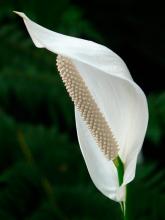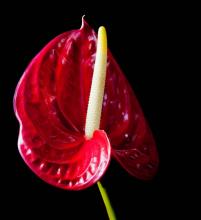When you know what to plant next to this or...
-
Images of Peace Lily
Peace Lily: 7 Major Care Tips
The peace lily is very easy to take care of. They are very popular and even famous as the closet plants. The pure white flowers look really lovely in any type of interior. Since it is one of the most popular house shrubs because taking care of it is a piece of cake it has many fans and followers.
✔ We Released The Peace Lily HandBook
CLICK HERE TO LEARN MORE >>And even if you are worried about the lack of experience any gardener can handle taking care of it, even the most inexperienced one. Follow our guidelines and you will be able to get the best out of your lily.
We have gathered all the information on how to take proper care for the shrub. This house plant will serve you for many years. It gets more and more popular. Especially now that the NASA has acknowledged that it breaks down and neutralizes the harmful gases such as carbon monoxide and formaldehyde making it very useful for the household as it provides you with cleaner fresher air.

Growing these amazing shrubs is a great idea because you will have very cute white flowers without wasting too much time on the plant care. Getting one of these beauties for your house or garden is also very easy as the herb is very popular with the plant shop owners for its being in demand. No matter if you already have a peace lily or you are simply considering getting one for your home we have you covered.
Indoor Plant Care - 5 Basic Requirements
So you must be wondering how to care of your peace lilies and to make sure you provide them with the proper care? What is good about the shrub is that you can grow it indoors or outdoors. Repotting peace lily as much as you need to without damaging it is pretty simple.
Peace lilies care tips:
- In winter this herb requires less water but many gardeners wait for it to drop a little and then water it. Generally you need to moist it once a week. Spray the leaves in summer to keep them cool and moist. 4
The shrub feels happy in the room temperature that is comfortable for people. But if the temperature drops below 7 C then it might get seriously damaged and this can led to dying.
- You need indirect sunlight for the lily. It also thrives under the luminescent lamps in the rooms with no windows at all.
- To get as much flowering as you can and to unleash the full potential uses the indoor fertilizer in spring and summer. Follow the package instructions.
- If the lily is looked after properly the blooming might last throughout autumn as well. One bloom usually lasts for about two months or more.
This way you will ensure the proper growing. And also remember that here will be no flowers in winter. The peace lilies care guide is pretty simple. Give it some love and attention and your lily will flourish for many years.

Repotting the Peace Lily: Make Everything Right
The perennial indoor shrubs need to be repotted regularly depending on their growth rate, specific needs and the pot size. What if your flower pot seems to be very busy and there is less and less flowering every season?
That means that that it is probably the time to think about providing the lily with a new bigger pot. The lily needs to have clay, plastic or metal pot with draining holes. Also place a coffee filter or the paper towel at the bottom to stop the water from washing out the soil. Follow these simple steps:
- The shrubs thrive in the pots that are only slightly bigger than the root system. So repotting the peace lily in the container a few inches bigger than the previous one.
- Fill the pot by one third with the planting soil. Water it and let the water drain for like an hour.
- Loosen the root by sliding the knife between the wall of the pot and the soil.
- Clear the roots of the old soil by as much as possible without damaging it.
- Place the root ball in the new pot so it is an inch below the tip of the pot.
- Fill in the soil till the roots are covered. Then just water the plant.
The repotting is one of the major care guide features. And it will not require any special skills or knowledge as long as you are being careful and do not damage the roots.
Growing Outdoors
The Japanese peace lilies are also simply known among gardeners as peace lily has originated in the tropical rainforest. What it needs is warm temperature and plenty of indirect sunlight. Draughts might lead to this flower dying.
The temperatures below 7 C can harm it as well. So basically it feels just as good outdoors as it is indoors in the areas with warm moist climate resembling its natural tropical habitat. But remember to be careful when taking the plant outside in the arid or cool climate.
Follow these simple steps to ensure the proper outdoor care. First of all find a nice spot with plenty of shade as plenty of unfiltered sunlight will do wonders to it making this perennial shrub explode with flowers.
Make sure the droughts will not bother the pot by placing it in the corner or some other cozy area of the garden. A shady patio might be a great place as well. And remember that since you will have to take it back into the house in autumn keep the plants in the pot even when placing them in the garden.
So you are probably wondering how to get as many flowers as possible. Why won’t the beautiful lily flower you have at home bloom all the time. You have to remember that most of the natural species produce inflorescences from May to November. Some shrubs have shorter blooming periods.
However, modern hybrids have been interbred with many different species to provide more flowers and there are two types that can actually flower throughout the year. But how can you tell the DNA of your flower? Most cultivars will try to come back to their original blooming period rather than following the cultivated line.

Various Illnesses Symptoms and Their Meaning
The lily plant has a number of possible illnesses. We have collected the main guidelines that you should follow to take care of the possible insects or fungus especially if it grows outside. If taken care of properly your shrub will give you the best of its growing potential. We have some simple insect control tips:
- The aphides leave sticky slime covers. Wash those off with the spray water and then clean the leaves with the insecticidal soap that works well on aphides.
- Mealy bugs leave white nets that lead to early leaves and stems yellowing and shrinking. Apply insecticidal soap or clean the nets off with the cotton ball dipped in the isopropyl alcohol.
- Spider mites cause leaves browning and falling off, webbing in between the leaves. Apply insecticidal soap or clean the nets off with the cotton ball dipped in the isopropyl alcohol.
- The black leaves are a sign of the frost damage. Remove the dead leaves and take the plant into the house.
- Leaves wilting despite regular moisturizing. The roots have rotten, repot immediately after leaning the roots of dead rotten or slimy parts.
- Grey fuzz on the soil. Fungus that is not harmful but ruins the aesthetic look. Sprinkle it with the cinnamon infused water that is a natural fungicide.
- Black coating on the leaves. You might want to discard of the plant and the soil before the fungus has not damaged other plants. You can try to clean the plant of the infected leaves and water it with compost tea that contains fungus fighting bacteria.
But be aware that the house lilies will not bloom as much as when you have seen this beautiful flower pot in the shop. Of course the retailers will do everything to make the plant look more attractive by all means possible. And for this they use Gibberellic Acid that is commercially distributed under the name of GA3.
Examine the leaves carefully. If you notice that some leaves have a strange shape but the shrub itself is covered in flowers then most likely the salesmen use chemical boosters on them. Of course the retailers know the right amount that can make all the pots bloom simultaneously making it look like you will have the same amount of flowers at home.
Remember that the flowers that have been fed Gibberellic Acid get used to the huge doses of hormones and once taken off them at your house they are very likely to produce even less flowers. However do not attempt to use the GA3 at home as the wrong amount can be really hazardous to the plant.
We suggest you use the proper fertilizer as well as drained moist soil. Combined together with other close to natural conditions this will help the plant feel comfortable without artificially boosting the inflorescences and allowing it to develop according to the natural DNA.

Yellow and Brown Leaves: 3 Main Causes
Even thought not being too picky for the environment your lily can suffer from the basic plants issues like the lack of proper watering etc. The flowering might stop and the blossoms will shrug as well as the glossy green leaves.
These at home flowers have certain needs for the light and moisture. Follow these basic steps on how you should take proper care of your lily so there will be no more yellow or brown leaves on the shrub:
- The sun burn. If you leave the peace lily outside and notice that more and more leaves are turning yellow and brown over time that is most likely meaning that the environment is no good. And you need to move the pot to the shadier place. Or perhaps you decided to try and plant the shrub directly into the ground and the soil does not fit.
- The lack of water. Your lily feels best in the moist properly drained soil that dries slightly in between the watering. However the older leaves at the base might naturally go yellow and fall off. This does not sign the need for more water.
- Insufficient magnesium or iron levels make the leaves go yellow while the veins remain green. If the plant lacks nitrogen the leaves will turn completely yellow. And if in needs more potassium that will show on the dry yellow tips.
Japanese Peace Lily Origins
Your Japanese peace lily aka Spathiphyllum (Spathe) is native to the tropical America and Southeast Asia. And actually is a common name for about 200 different lily types. This common name Spathiphyllum is used for all the peace lilies. Altogether their types and hybrids are a part of Araceae family that is commonly referred to as aroid.
None of the wild species is good for planting indoors. All the pot plans are the result of the Asian lilies hybridization and breeding that started from the time when the collectors travelled to Asia for some new interesting species for the European breeders.
There are numerous leaf shapes and sizes, for example the Commutatum in Malaysia, Asia and Solomon Islands can grow up to 33 inches tall. But most of the species can be found in the Columbian lowlands enjoying the damp warm climate and thriving for up to 8 inches tall.
The common name comes from the white flowers that look like tiny peace flags. The leaves also provide a since of tranquility and relaxation. The Victorians have domesticated it around 1800s. The Spathe is still one of the most popular shrubs and a common house plant due to the ease of care and beautiful white blossoms.

Dogs and Cats Poisoning Threat: 7 Main Mild Intoxication Symptoms
Your lily has its own threats and disadvantages. The shrub is mildly toxic and so it can be poisonous to cats and dogs. The peace lily intoxication symptoms are:
- Vomiting
- Drooling
- Pawing at the mouth
- Inappetence
- Oral pain
- Swallowing and breathing difficulties
- Swelling
Chewing on the plant can cause the abovementioned symptoms immediately as calcium oxalate crystals release in the oral cavity. The poisoning can cause mouth and nose swelling however it does not cause kidney failure like the Tiger lilies do.
The animals might change the tone of voice due to the swelling it can meow differently. Also your pets will refuse having food for a few hours. Usually that is about it. The pain and swelling will be gone in a few hours and to help getting rid of it you can give something rich in calcium like milk or yoghurt. We advice you keep the house plant away from the pets making sure the animal does not try chewing on it.
Since the stomach and mouth irritation starts at the first bite the animal will be turned away from the plant pretty quickly. Besides mild poisonous to dogs and cats threat there are no other possible dangers to your household.
We really hope that this simple care guide will be useful for you no matter if you are a newbie or an experienced gardener. Feel free to let us know what you think and contact us in case of any other questions on how to care for your flowers arising.
✔ We Released The Peace Lily HandBook
CLICK HERE TO LEARN MORE >>








 ,
,  ,
,  ,
,  ,
,  ,
, 



